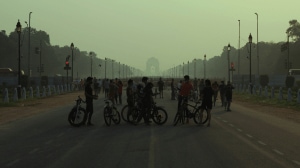The great Indian vote trick
My most interesting day was the day after the counting — more than the day of the voting or the day of the counting. I have read the to...

My most interesting day was the day after the counting — more than the day of the voting or the day of the counting. I have read the tortuous explanations offered by analysts and columnists on the results of the elections in three States and in the Union Territory of Delhi, and the winner by a huge margin is Mr Harish Khare of The Hindu for having discovered the ‘‘rainmaker’’ as the force behind the results!
Everyone was wrong. I got Rajasthan wrong. There were no surprises in the results from Delhi, Madhya Pradesh or Chhattisgarh. (If anyone believed that the outcome in these three States would be the opposite of the actual result, it is because he or she must have wished the opposite result. If wishes were horses, beggars would ride). Ms Sheila Dikshit won because of her clean image and good governance. Mr Digvijay Singh lost because he read the wrong books and listened to the wrong people on governance. Mr Jogi lost a winnable election because he was too clever by half. The inexplicable result is the Congress’ defeat in Rajasthan.
The positive side
Let us first look at the positive side of these elections. The BJP has come a long way from its origins. It must have been quite tempting to mount the Hindutva horse that romped home to victory in Gujarat. The Hindutva mascot (Mr Narendra Modi) was ready and willing, and neither Mr Jaitley nor Mr Mahajan is a squeaky-clean secularist. But to their credit, this time they played the ‘development’ tune and emerged victorious. In Delhi the ‘development’ agenda was pre-empted by Ms Dikshit; and in Chhattisgarh it was not required at all against a self-destructing Mr Jogi.
The election results have, in my view, corrected a glaring asymmetry in the governance of the country. There was an asymmetry because the BJP ruled at the Centre but in only three States, while the Congress ruled in 14 States but not at the Centre. After these elections, the system, as a whole, looks more like a two-party system. I concede that there is still some distance to travel before we have a truly two-party system. Purely State-level parties like the Shiv Sena, TDP, DMK, AIADMK, SP, BJD or the AGP will not fade away soon or easily, but every one of them has shown a willingness to be co-opted as an ally of the BJP.
A two-party system is the best thing that can happen to India. In such a system, the voters will have a clear choice between the two key players. Besides, winning will be sweet and losing will not be too bitter. The loser will adorn the Opposition benches and can play the waiting game. Each party will be compelled to unveil an agenda, take positions on crucial issues, convince the people that it has a better plan for every problem and, above all, announce its playing eleven. In that situation, the BJP cannot enjoy the luxury of speaking in many voices (and being different things to different sections). Equally, the Congress cannot afford to hide a whole party behind its leader.
The development dividend
Development as the theme song of politics will yield multiple dividends. For example, it will put divisive issues on the backburner. Look at the transformation it has worked on Ms Uma Bharti. She may still wear the ochre robes of a sanyasin but, in the office of Chief Minister, she is unlikely to spew the rhetoric of 1992. On the Congress’ side, the dividend may be in the form of a less reticent leader and less ambivalence in taking positions on economic reforms, minority rights and corruption. Both parties may be compelled to declare another welcome dividend — promoting new and younger leaders, allowing them to assume responsibility and projecting a collective leadership.
A two-party system will also largely remove the uncertainties that an election holds for the people. If the ruling party is on a losing wicket, the voters need not worry about the next government or about its stability. One party-government will be replaced by another, and the business of government will go on without unsettling interruptions or shocks.
From every point of view, the results of Elections 2003 bring greater hope and cheer. 2:2 would have been more even-handed justice, but 3:1 is not so bad. After all the Congress still has 11 States under its umbrella, and can begin preparing for the big battle of 2004.
A poll primer
The Congress would also do well to learn a few lessons from the BJP School of Election Management:
• Firstly, there is a new voter out there. He or she has no time for history, no sense of nostalgia and no permanent loyalties. He or she looks to the future and follows whoever appears more capable of delivering on roads, electricity, water and jobs. Incumbency is a millstone.
• Development is a tune that the party in opposition can sing better than the party in government. Whatever development has taken place, there still will be a lot of under-development. Hence, attack works better than defence.
• Old warhorses are better put to sleep. The voters respond enthusiastically to new colts and mares.
• Elections can be reduced to one phrase: ‘‘connecting with the people.’’ Television makes the connection. He who is most frequently seen on television is the leader. The 30-second byte is the message. By that standard, the BJP had a dozen leaders to the Congress’ one (Ms Sonia Gandhi).
• Bloc voting is the rule all over the world. In India, caste usually determines the bloc. Electioneering is about wooing and winning blocs. Women seem to be emerging as a bloc, and may be the deciding factor in 2004. In 2004, the BJP will be the incumbent party. It will be the defending side. Mr Vajpayee will appear to be the old warhorse. His appeal among women is uncertain and unproved. Therefore, if the lessons of 2003 are learnt by the Congress, it is possible to turn the tables on the BJP. For the good of democracy, the Congress should immediately don the battlegear. The last thing it should do is to appoint a committee under the very decent, very non-political Dr Manmohan Singh to go into the causes of its defeat. The causes and the remedies are there in full view of anyone who cares to see.
Write to pc@expressindia.com






- 01
- 02
- 03
- 04
- 05

























